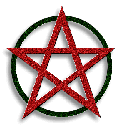| Contents GwP
Vote For GwP here
Please take the time to vote for GwP at the WPR top 100
pagan sites
The Burning Times
A brief history of wicca,witches. History is a very
important aspect of wicca.
Wiccan Rede
These are the basic laws that we fallow. Do not take
these words lightly.
Book of Shadows
I should call this the book of light since this is not a private collection. The
bos is a useful tool
What is Wicca?
GwP's answer for that eternal question
Sabbaths
The 8 Wiccan holidays and there meanings
Wicca FAQ
This FAQ is for those who know nothing/close to nothing
about wicca
Charge of the goddess
The Goddess and what she is to Wicca.
Charge of the god
The god and what he is to Wicca.
Tarot spreads
Tarot spreads Compiled by David. c. Jones. One of the
best I have seen.
Herbs
Just a small section on herbs will be adding to it
soon.
Forum
A general Wiccan message forum I will be happy to
answer any questions you have there.
Runes
The Basics on one of the oldest forms of divination
Witchy Tools
The Basic ritual tools and how to use them
|
|
 
The Burning Times
the religion of Witchcraft dates back about 25,000 years, to the
Paleolithic Age, where the God
of Hunting and the Goddess of Fertility first appeared.
Out of respect for the overwhelming power of Nature grew a belief in beings, gods, who
controlled
the winds, the seas, the earth and the fires.
Success in the hunt and ensuring the continuation of the human species were of great
importance
in those times, thus practitioners of this early religion felt the need to gain the favor
of
these gods.
Magick was used to direct the hunting and to ensure fertility of the women of the tribes.
Woman
was the vessel of life, and because she contained life, she contained magic.
Wica was the name originally given to the priesthood of the Old Religion, which by 500 or
so BCE
(before common era) had began developing set rituals and festivals. The Sabbats celebrated
the
turning of the Wheel of the year; the movement from birth to death to rebirth.
But a time came when masculine ideals and male gods began to rise
and challenge the Mother Goddess. Families began to be traced
through the male lineage, rather than through the mother, and men
took over the chief places of the priesthood.
Soon, the old ways of the common people came into conflict with a new religion that
started with
rulers and upper classes - Christianity.
An attempt at mass conversion was made by Pope Gregory the Great, who thought that one way
to get
people to go to Christian churches was to build them on sites of the Old Religion's
meeting
places.
In an effort to establish this new religion, many Old Ways were adapted.For
example, the Egyptian Trinity of Isis, Osiris, Horus became Mary, God and Jesus.
And although biblical evidence shows that Jesus was born in late summer or fall,
the Church of Rome in the middle of the fourth century declared Dec. 25 as the
date of Jesus' birth. Dec. 25 falls very close to the Old Religion's celebration of the
Winter
Solstice - the birth of the Sun. (note that the Christians celebrate the birth of the Son)
When the Christians decided that their new ways weren't catching on fast enough,
things got a lot rougher for those who were practicing the Old Religion.
Christian leaders began asserting that Witches were devil worshippers and savages.
Women, who menstruate and give birth, were identified with sexuality and therefore
with evil.
December, 1484 marked the publication of the Bull of Pope Innocent VII, which delegated
Heinrich
Kramer and Jakob Sprenger as inquisitors. These two men in turn created the Malleus
Maleficarum,
which details the tortures that could be used to obtain confessions to Witchcraft. It was
this
sinister work that sparked a hysteria which spread rapidly across Europe.
I don't think anybody truly knows how many people were burned, tortured or
otherwise killed during that time - although scholarly estimates put the number
between 40,000 and 100,000 - but the ironic thing is that the vast majority of
them probably were not Witches. Most are believed to have been devout Christians
who were wrongly accused. Victims were the elderly, the senile, homosexuals and
freethinkers.
Once denounced, a suspected Witch was arrested and then hideously tortured into a
confession.
Suspects were subjected to thumbscrews, the rack, boots which broke the bones of the legs;
they
were deprived of sleep, starved and beaten.
At times, hundreds of suspected Witches were killed in a day.
The Craft eventually was forced to move underground in order to survive.
Unfortunately, when the persecutions ended in the 18th century, the stereotype of
Witches as devil worshippers remained for those who were uninformed of the true
nature of the Craft. It is only in this century that we are able to come out of
the "broom closet" and reclaim the word Witch as one that means wise one,
follower of the Old
Ways.
|

